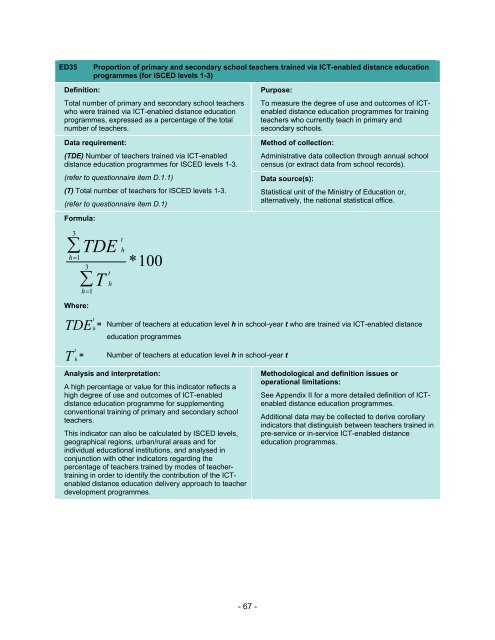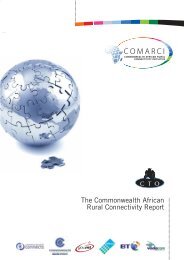Guide to measuring information and ... - unesdoc - Unesco
Guide to measuring information and ... - unesdoc - Unesco
Guide to measuring information and ... - unesdoc - Unesco
Create successful ePaper yourself
Turn your PDF publications into a flip-book with our unique Google optimized e-Paper software.
ED35 Proportion of primary <strong>and</strong> secondary school teachers trained via ICT-enabled distance education<br />
programmes (for ISCED levels 1-3)<br />
Definition:<br />
Total number of primary <strong>and</strong> secondary school teachers<br />
who were trained via ICT-enabled distance education<br />
programmes, expressed as a percentage of the <strong>to</strong>tal<br />
number of teachers.<br />
Data requirement:<br />
(TDE) Number of teachers trained via ICT-enabled<br />
distance education programmes for ISCED levels 1-3.<br />
(refer <strong>to</strong> questionnaire item D.1.1)<br />
(T) Total number of teachers for ISCED levels 1-3.<br />
(refer <strong>to</strong> questionnaire item D.1)<br />
Formula:<br />
3<br />
TDE<br />
h1<br />
3<br />
T<br />
h1<br />
Where:<br />
t<br />
h<br />
t<br />
h<br />
* 100<br />
- 67 -<br />
Purpose:<br />
To measure the degree of use <strong>and</strong> outcomes of ICTenabled<br />
distance education programmes for training<br />
teachers who currently teach in primary <strong>and</strong><br />
secondary schools.<br />
Method of collection:<br />
Administrative data collection through annual school<br />
census (or extract data from school records).<br />
Data source(s):<br />
Statistical unit of the Ministry of Education or,<br />
alternatively, the national statistical office.<br />
TDE t<br />
= Number of teachers at education level h in school-year t who are trained via ICT-enabled distance<br />
h<br />
education programmes<br />
T t<br />
= Number of teachers at education level h in school-year t<br />
h<br />
Analysis <strong>and</strong> interpretation:<br />
A high percentage or value for this indica<strong>to</strong>r reflects a<br />
high degree of use <strong>and</strong> outcomes of ICT-enabled<br />
distance education programme for supplementing<br />
conventional training of primary <strong>and</strong> secondary school<br />
teachers.<br />
This indica<strong>to</strong>r can also be calculated by ISCED levels,<br />
geographical regions, urban/rural areas <strong>and</strong> for<br />
individual educational institutions, <strong>and</strong> analysed in<br />
conjunction with other indica<strong>to</strong>rs regarding the<br />
percentage of teachers trained by modes of teachertraining<br />
in order <strong>to</strong> identify the contribution of the ICTenabled<br />
distance education delivery approach <strong>to</strong> teacher<br />
development programmes.<br />
Methodological <strong>and</strong> definition issues or<br />
operational limitations:<br />
See Appendix II for a more detailed definition of ICTenabled<br />
distance education programmes.<br />
Additional data may be collected <strong>to</strong> derive corollary<br />
indica<strong>to</strong>rs that distinguish between teachers trained in<br />
pre-service or in-service ICT-enabled distance<br />
education programmes.
















